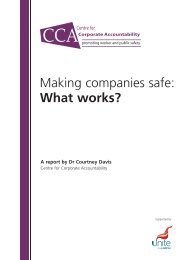Manual Handling Manual Handling Operations Regulations 1992 ...
Manual Handling Manual Handling Operations Regulations 1992 ...
Manual Handling Manual Handling Operations Regulations 1992 ...
You also want an ePaper? Increase the reach of your titles
YUMPU automatically turns print PDFs into web optimized ePapers that Google loves.
Health and Safety<br />
Executive<br />
Appendix 4<br />
Examples of assessment checklists for lifting and<br />
carrying and pushing and pulling<br />
1 A suitable and sufficient risk assessment is required when hazardous manual<br />
handling is unavoidable. The assessment should identify where the risk lies<br />
and identify an appropriate range of ideas for reducing the potential for injury. A<br />
checklist can help with this process by applying a systematic examination of all the<br />
potential risk elements. To ensure that the assessment covers all potential risks the<br />
workforce should be fully involved in the risk assessment process.<br />
2 Examples of basic checklists for lifting and carrying and pushing and pulling<br />
are included in this appendix. Their use will help to highlight the overall level of risk<br />
involved and identify how the job may be modified to reduce the risk of injury and<br />
make it easier to do. It will also be useful in helping to prioritise the remedial actions<br />
needed. The checklists may be copied freely or may be used to help design your<br />
own assessment checklist.<br />
3 The following notes are intended to help you complete the checklist.<br />
(a)<br />
(b)<br />
Section A: Describe the job. There is space available for a diagram to be<br />
drawn to summarise the task in a picture, as well as for a written description.<br />
Section B: Tick the level of risk you believe to be associated with each of<br />
the items on the list. Space is provided for noting the precise nature of the<br />
problem and for suggestions about the remedial action that may be taken.<br />
It may also be useful to write down the names of the relevant people or<br />
groups in your organisation who you will wish to consult about implementing<br />
the remedial steps, for example managers, workforce trainers, maintenance<br />
personnel or engineers and relevant employees or their safety representatives.<br />
If you are assessing a lifting, carrying or team-handling operation and need<br />
help in judging the level of risk, you can consider using the MAC (Appendix 5)<br />
to help you decide the risk levels to be entered in Section B of the checklist.<br />
Some tasks may involve more than one operator, each with a different level<br />
of risk, depending on the exact nature of their duties. If you wish to use the<br />
same checklist for all of the operators involved, you can allocate a number (or<br />
other identifying mark) to each and use that against each tick. Alternatively<br />
you can use a separate checklist for each operator.<br />
(c)<br />
(d)<br />
Decide whether the overall risk of injury is low, medium or high. This will help<br />
to prioritise remedial action if you have a large number of risk assessments<br />
to carry out. Ring the appropriate word at the bottom of Section A after you<br />
have completed Section B.<br />
Section C: Summarise the remedial steps that should be taken, in order<br />
of priority. The assessor’s name, the name of the person responsible for<br />
carrying out any remedial action and the date by which such action should be<br />
completed should be recorded. Only once such action has been taken should<br />
the final column be completed. It may also be useful to enter the target date<br />
for reassessment if this is appropriate. Remember to check that any actions<br />
taken have the desired effect.<br />
<strong>Manual</strong> handling Page 63 of 90
















